
Whelks are any of several carnivorous sea snail species with a swirling, tapered shell. Many are eaten by humans, such as the common whelk of the North Atlantic. Most whelks belong to the family Buccinidae and are known as "true whelks." Others, such as the dog whelk, belong to several sea snail families that are not closely related.
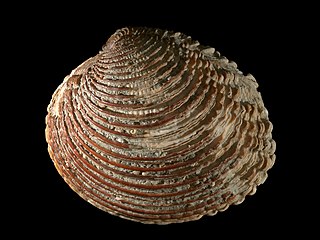
The Veneridae or venerids, common name: Venus clams, are a very large family of minute to large, saltwater clams, marine bivalve molluscs. Over 500 living species of venerid bivalves are known, most of which are edible, and many of which are exploited as food sources.

Dosinia is a genus of saltwater clams, marine bivalve molluscs in the family Veneridae, subfamily Dosiniinae Deshayes, 1853. The shell of Dosinia species is disc-like in shape, usually white, and therefore is reminiscent of the shells of Lucinid bivalves.
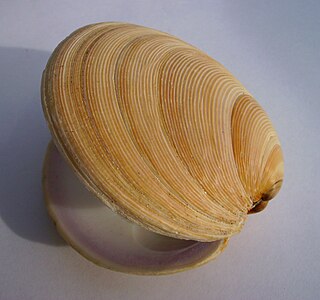
Dosinia anus, commonly named the ringed dosinia, coarse dosinia, coarse biscuit shell and tuangi-haruru, in the Māori language, is a species of saltwater clam, a marine bivalve mollusc in the family Veneridae, the venus clams. The species is common to both of the main islands of New Zealand, where it is the largest and heaviest species in the genus, occasionally exceeding 80 mm in diameter. It buries itself in clean fine sandy substrata, sub-tidally down to 15 m deep.

Anadara brasiliana is a saltwater clam in the family Arcidae, the ark shells. This species is found along the Atlantic coast of North America, from North Carolina to Brazil.
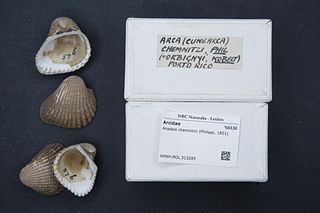
Anadara chemnitzii, common name Chemnitz's ark clam, is a saltwater clam in the family Arcidae, the ark shells. This species is found in the Caribbean Sea, from Texas to the West Indies and Brazil.

Lunarca ovalis, also known as the blood ark clam, is a species of clam in the family Arcidae. It can be found along North America coast of the Atlantic Ocean, ranging from Massachusetts to the West Indies and Brazil. It resides from the low-tide line to a depth of ten feet.

Glycymeris decussata, or the decussate bittersweet, is a species of bivalve mollusc in the family Glycymerididae. It can be found in Caribbean waters, ranging from Florida to the West Indies and Brazil.

Glycymeris undata, or the Atlantic bittersweet, is a species of bivalve mollusc in the family Glycymerididae. It can be found along the Atlantic coast of North America, ranging from North Carolina to the West Indies and Brazil.
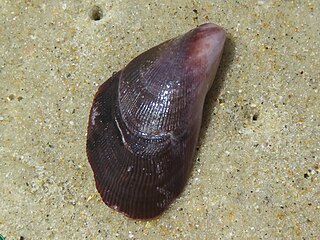
Brachidontes exustus, commonly known as the scorched mussel, is a species of bivalve mollusc in the family Mytilidae. It can be found along the Atlantic coast of North America, ranging from Cape Hatteras to the West Indies and Brazil.
Musculus lateralis, common name the Lateral mussel, is a small species of bivalve mollusc in the family Mytilidae. It can be found along the Atlantic coast of North America, ranging from North Carolina to the West Indies and Brazil.

Isognomon radiatus, the radial purse oyster or Lister's tree oyster, is a species of bivalve mollusc in the family Isognomonidae. It can be found along the Atlantic coast of North America, ranging from southern Florida to Brazil and Bermuda.

Nodipecten nodosus, or the lion's paw scallop, is a species of bivalve mollusc in the family Pectinidae. It can be found along the Atlantic coast of North America, ranging from Cape Hatteras to the West Indies, including Brazil and Bermuda.
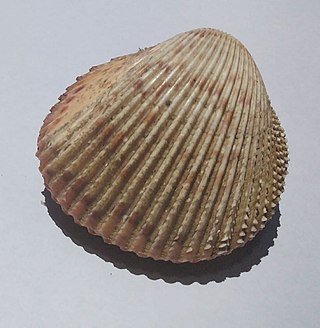
Dallocardia muricata, the yellow cockle, is a species of bivalve mollusc in the family Cardiidae. It can be found along the Atlantic coast of North America, ranging from North Carolina to the West Indies and Brazil.

Dosinia discus, or the disk dosinia, is a species of bivalve mollusc in the family Veneridae. It can be found along the Atlantic coast of North America, ranging from Virginia to Florida.
Dosinia elegans, or the elegant dosinia, is a species of bivalve mollusc in the family Veneridae. It can be found along the Atlantic coast of North America, ranging from North Carolina to Texas.

Dosinia dunkeri is a species of saltwater clam, a marine bivalve mollusc in the family Veneridae.
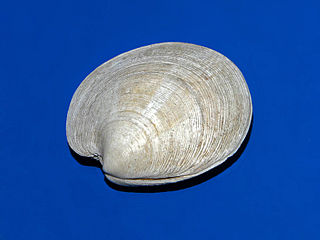
Dosinia exoleta, common name the rayed artemis, is a saltwater clam, a marine bivalve mollusc in the family Veneridae, the venus clams.















